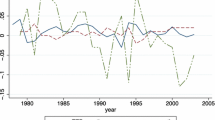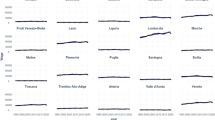Abstract
This paper provides a structural estimation of an equilibrium matching model with exogenous productivity growth on a sample of European Regions for the period 1976–2000. Using a three-stage least squares procedure, I estimate a simultaneous equation model for employment, wages and capital stock. The importance of the study of the relationship between growth and employment is due to the fact that the sign of this connection is not clear-cut. Theoretical models imply that the impact of productivity on employment is ambiguous. Furthermore, the empirical contributions are still not so many to reach a strong conclusion on the sign of the relationship above. This paper finds that the impact of productivity growth on employment is negative in the short-run and this effect remains negative even in the long-run. The implication of my results is that all new technology is embodied in new jobs and job creation plays no role in the employment dynamics of the sample I have considered.
Similar content being viewed by others
Notes
The error-correction (ECM) approach overcomes problem of common trends and thus spurious regression, due of potential non-stationarity of a dynamic model. Furthermore, the ECM incorporates both short-run and long-run effects.
References
Aghion P, Howitt P (1998) Endogenous growth theory. MIT Press, Cambridge
Ball L, Moffitt R (2001) Productivity growth and the phillips curve. In: Krueger AB, Solow R (eds) The roaring nineties: can full employment be sustained?. Russel Sage Fundation, New York
Blanchard O, Wolfers J (2000) The role of shocks and institutions in the rise of aggregage unemployment. Econ J 110:1–33
Mortensen DT, Pissarides C (1998) Technological progress, job creation and job destruction. Rev Econ Dyn 1:733–753
OECD (1980) OECD Economic Outlook, vol 1980/2. OECD Publishing
OECD (1985) OECD Economic Outlook, vol 1985/2. OECD Publishing
OECD (1990) OECD Economic Outlook, vol 1990/2. OECD Publishing
OECD (1995) OECD Economic Outlook, vol 1995/2. OECD Publishing
OECD (2000) OECD Economic Outlook, vol 2000/2. OECD Publishing
OECD (2005) OECD Economic Outlook, vol 2005/2. OECD Publishing
Phelps ES (1994) Structural slumps, the modern equilibrium theory of unemployment, interests and assets. Harvard University Press, Cambridge
Pissarides C (2000) Equilibrium unemployment theory. MIT Press, Cambridge
Pissarides C, Vallanti G (2007) The impact of TFP growth on steady-state unemployment. Int Econ Rev 48:606–640
Staiger D, Stock JH, Watson MW (2001) Prices, wages, and the US NAIRU in the 1990s. In: Krueger AB, Solow R (eds) The roaring nineties: can full employment be sustained?. The Russell Sage Foundation, New York
Author information
Authors and Affiliations
Corresponding author
Appendix: data definitions and source
Appendix: data definitions and source
Data are mainly from Cambridge Econometrics, a validated database of economic indicators for cities and regions. The database draws on the available official data at European and national levels and has undergone a substantial process of updating and quality checks to improve its consistency, timeliness and coverage. The current database includes output, employment, household expenditure, investment expenditure, demographic indicators (total and working population).
The regions in the sample are presented in Table 4.
- Y :
-
Gross Value Added in constant prices (base year 1995)
- L :
-
Total Employment (source: Cambridge Econometrics)
- P :
-
Working Age Population (source: Cambridge Econometrics)
- w :
-
Real labor cost: it is computed from the compensation of employees data using 1995 as base year (source: Cambridge Econometrics)
- K :
-
Real capital stock. The calculation of the capital stock is made according to the Perpetual Inventory Method (see Chapter 2). Data on investment expenditure are from Cambridge Econometrics
- A :
-
Total Factor Productivity (TFP). It is obtained by estimating a production function with region fixed effects and time dummies for each year in the sample. The estimated equation for production function is: (ln Y it = a i + γ t + α i ln K it + β i ln L it + ɛ it ), where a i is a regional specific effect, γ t a common time effect and ɛ it is a random shock. The parameters α and β are the elasticities of capital and labour with respect to output, respectively. The production function has been estimated using the group mean FMOLS developed in Pedroni (2000) in order to obtain valid standard errors. The method modifies least squares to account for serial correlation effects and the endogeneity in the regressors that results from the existence of cointegrating relationship. From the estimated fixed effects I calculate the antilogarithms, which represents the parameter of technological efficiency for each region.
- rir :
-
Real interest rate (source: OECD Economic Outlook, various issues)
- union :
-
Net union density is constructed as the ratio of total reported union members (less retired and unemployed members) (source: Nickell et al. 2001)
- unr :
-
Unemployment rate (source OECD)
- tax :
-
Tax wedge consists of the payroll tax rate plus the income tax rate plus the consumption tax rate (source: Nickell et al. 2001)
- rer :
-
Benefit entitlement before tax as a percentage of previous earnings before tax. Data are averages over replacement rates at two earnings levels and three family types (single, with dependent spouse, with spouse at work). They refer to the first year of unemployment (source: Nickell et al. 2001, constructed from OECD data sources)
- BD :
-
Benefit duration defined as a weighted average of benefits received during the second, third, fourth and fifth year of unemployment divided by the benefits in the first year of unemployment (source: Nickell et al. 2001, constructed from OECD data sources)
- p :
-
Consumer price index (source: OECD Economic Outlook, various issues)
Rights and permissions
About this article
Cite this article
Ladu, M.G. The relationship between total factor productivity growth and employment: some evidence from a sample of European Regions. Empirica 39, 513–524 (2012). https://doi.org/10.1007/s10663-012-9202-y
Published:
Issue Date:
DOI: https://doi.org/10.1007/s10663-012-9202-y




